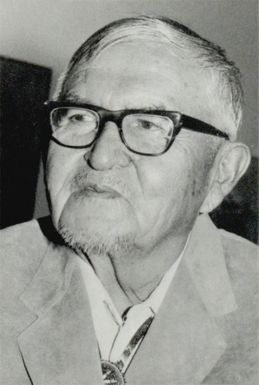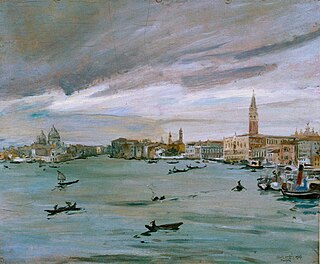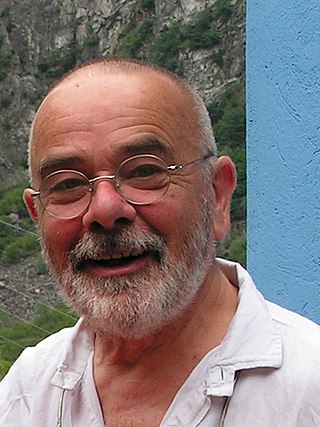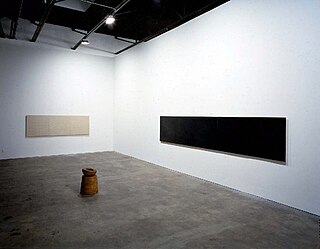
Allan Graham, known also as Toadhouse, (born 1943 in San Francisco, California) is a contemporary American artist based in New Mexico. His work includes sculpture, painting, poetry, and video.

Allan Graham, known also as Toadhouse, (born 1943 in San Francisco, California) is a contemporary American artist based in New Mexico. His work includes sculpture, painting, poetry, and video.
Graham studied at the San Francisco Art Institute and San José State University before moving to Albuquerque, New Mexico, where he received a Bachelor of Fine Arts from the University of New Mexico (1967). [1]
His early paintings were wall-like grids which, in the mid to late 1970s, developed into more open compositions with sweeping arcs and herring-bone patterns. [2]

In 1983, he abandoned conventionally shaped canvases in favor of eccentric forms and began leaving the stretcher bars exposed. By the mid-1980s this had evolved into a series of painting-sculpture hybrids, using wood, canvas, newspaper and book pages, which resembled certain African works. [3] These were followed by near-monochromes on bent canvasses, sculptures made of books and irregularly circular paintings using book pages from sources such as a Navajo Bible and Dante's Inferno.
In the 1990s, he painted a series called "Cave of Generation", which consisted of steps leading into large monochrome and two-tone paintings. These were followed by a series titled "Pre-hung (for those who suffer form)" which consisted of single and double doors painted with a palette knife.

In 1990 his work began to appear under the pseudonym of Toadhouse, which came from an underground structure he and his son built in Albuquerque, New Mexico, which attracted toads. The works under the Toadhouse name are word based. In one series he pasted bumper stickers with haiku like slogans on re-chromed car bumpers. In his Cosmo-logical and UFO series, he used tiny words written in graphite. [4]
In an interview done with Graham in The Brooklyn Rail , art critic John Yau said:
I think what goes on in your work is this incredible compression that we have to unpack, and, as we unpack it, we have to deal with our own sense of what these words mean to us or how they have some aspect of our habit of thinking, and then maybe take it apart a little. [5]
In addition to physical artwork, two books of Toadhouse poems have been published: Shit Floats Life Goes On (Toadhouse, 1990) and Visual Eyes, Translations from Toadhouse (Ethan J. Wagner, San Francisco, 1991). His poems have also appeared in In Company, an anthology of New Mexico poets after 1960 (University of New Mexico Press, 2004).

Graham has been influenced by Zen Buddhism and Buddhist poetry. [5] A large installation piece titled Time is Memory, which appeared in SITE Santa Fe, included sixteen zafus in front of which were placed famous Buddhist death poems. He has also cited Robert Creeley as an influence. The latter was also part of a video, poetry, photo installation project called “Add-Verse” which he did in conjunction with artist Gloria Graham, his spouse.

Pietro Consagra was an Italian sculptor. In 1947 he was among the founding members of the Forma 1 group of artists, who advocated both Marxism and structured abstraction.

Felice Casorati was an Italian painter, sculptor, and printmaker. The paintings for which he is most noted include figure compositions, portraits and still lifes, which are often distinguished by unusual perspective effects.

Allan Capron Houser or Haozous was a Chiricahua Apache sculptor, painter, and book illustrator born in Oklahoma. He was one of the most renowned Native American painters and Modernist sculptors of the 20th century.

Aldo Carpi was an Italian artist, painter and writer, author of a collection of memoirs concerning his imprisonment in the infamous Mauthausen concentration camp.
Willy Leopold Guggenheim, known as Varlin, was a Swiss painter. His figurative work emphasized the fragility of everyday life.

Charles William Bolsius was a Dutch-born American painter. He was born in 's-Hertogenbosch, the Netherlands, the youngest in an upper-middle-class bourgeoisie family. His father ran the regional Gas Works and Bolsius formally studied art in The Hague before emigrating to the United States and moving to New Mexico in the early 1930s. He quickly assimilated into the art communities of Albuquerque and Santa Fe showing with the significant artist of the period. Bolsius had artistically matured within Dutch - German Expressionism. His woodblock handprints, using subject matter from the American West, capitalized on flat, bold, stark patterns and rough-hewn effects that were hallmarks of the expressionist woodblock tradition. His heavy light-filled moody paintings with cloudy brooding skies combined expressionistic influences with expansive western landscapes and the optimism of American impressionism. His work was critically recognized and exhibited at major museums and galleries throughout New Mexico and Arizona.

Lawrence W. Carroll was an Australian-born American painter who established a career on both sides of the Atlantic. His works are held in museums around the world and he notably was included in major exhibitions such as Documenta IX and the Venice Biennale In his early career Carroll worked as an illustrator for The Progressive, The Village Voice, The New York Times, The Los Angeles Times, Newsweek, The Nation, Reason, Spin, Ray Gun, and other periodicals drawing political illustrations and notably he designed the artwork for the American thrash metal band Slayer's album covers. However it is Carroll's career as a painter that is most significant. His approach to materials, to the scale and structure of the objects is highly distinctive.

Gianfredo Camesi is a Swiss painter.
Fritz Glarner was a Swiss-American painter.

Fillìa was the name adopted by Luigi Colombo, an Italian artist associated with the second generation of Futurism. Aside from painting, his works included interior design, architecture, furniture and decorative objects.
John Connell was an American artist. His works included sculpture, painting, drawing, and writing.

Gloria Graham is an American artist based in New Mexico. Her work includes sculpture, painting, and photography.

Achille Funi was an Italian painter who painted in a Modernist take on the Neoclassical style.
Florence Melva Pierce née Miller was an American artist best known for her innovative resin relief paintings. Her work has often been linked with monochrome painting and minimalism.
Barry X Ball is an American sculptor who lives and works in New York City.
Oli Sihvonen was a post-World War II American artist known for hard-edge abstract paintings. Sihvonen's style was greatly influenced by Josef Albers who taught him color theory and Bauhaus aesthetics at Black Mountain College in the 1940s. Sihvonen was also influenced by Russian Constructivism, Piet Mondrian, and Pierre Matisse. His work has been linked to Abstract Expressionism, Minimalism, Hard-Edge and Op-Art.

Małgorzata Turewicz Lafranchi is a visual artist. Born in Poland, since 1994 she has lived and worked in Bellinzona in the Ticino canton of Switzerland.
Bernadette Vigil is an American artist and illustrator whose work has been exhibited in museums and galleries nationally and abroad. She has produced permanent public artworks in the form of fresco murals for the cities of Santa Fe and Albuquerque, New Mexico. She has been commissioned to create religious frescoes in churches in New Mexico, and has been called a "master of the art of buon fresco" in the Santos Tradition. She has authored a book on Toltec spirituality, Mastery of Awareness: Living the Agreements. In 2002 it was published in Spanish as El Dominio de la Conciencia, and in 2005 it was published in German as Das Geheimnis der vier Versprechen.
Erik Saxon is an American visual artist, painter, and printmaker based in New York, whose work is associated with contemporary abstraction. During the late 1970s and 1980s, Saxon was a member of the Radical Painting Group, an artist collective established by Marcia Hafif and Olivier Mosset in New York, which focused on exploring the essential qualities of painting.